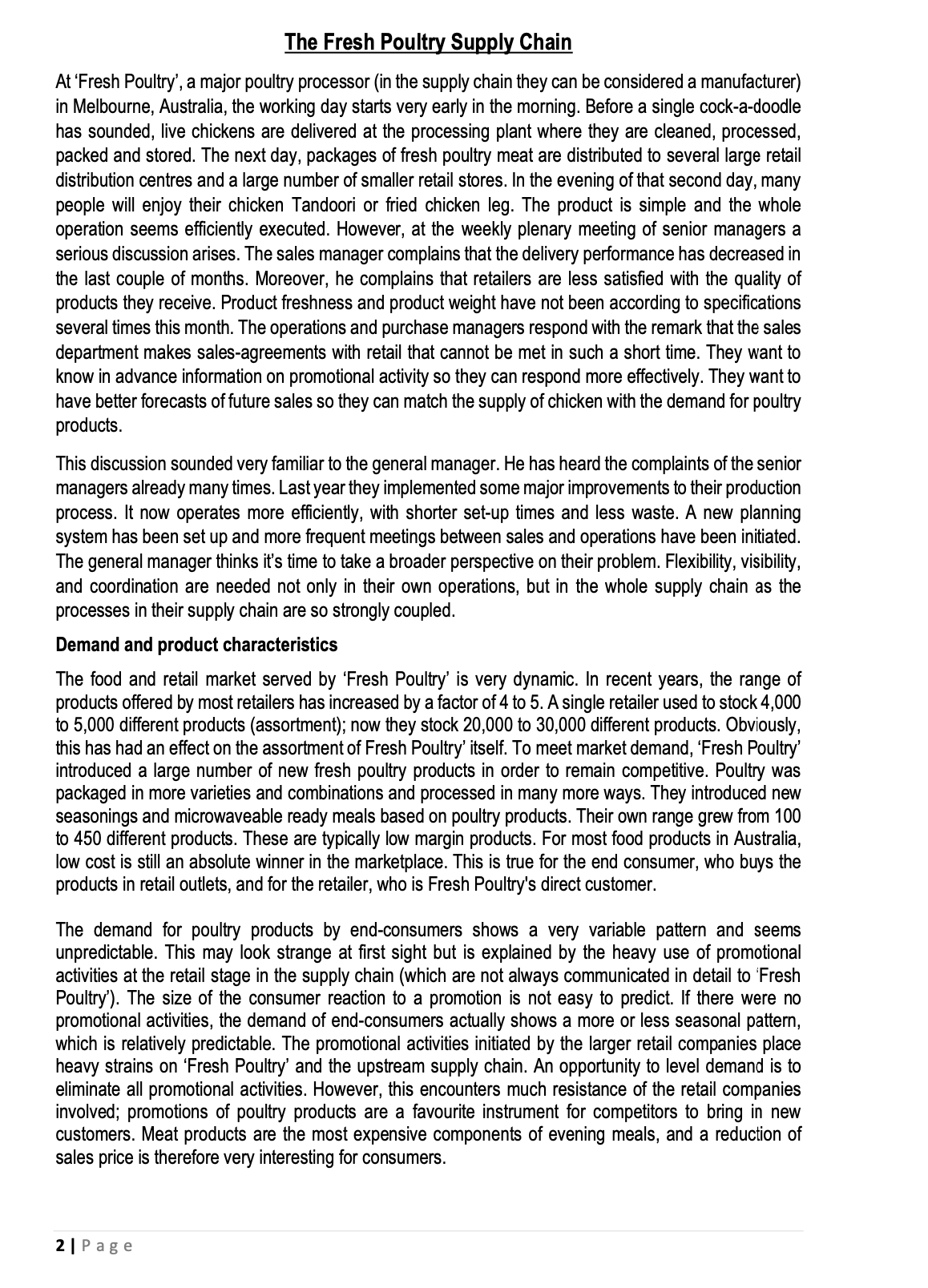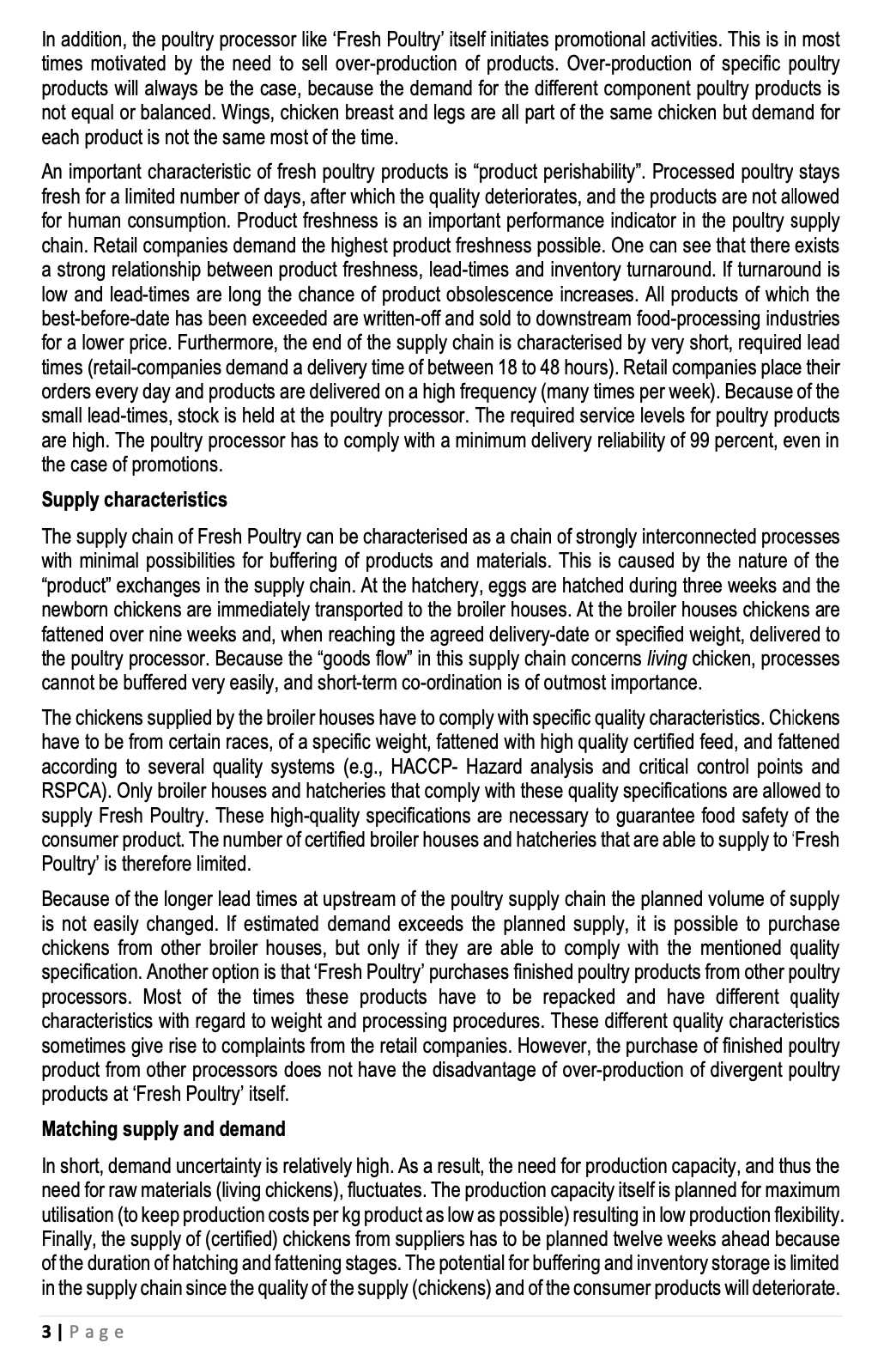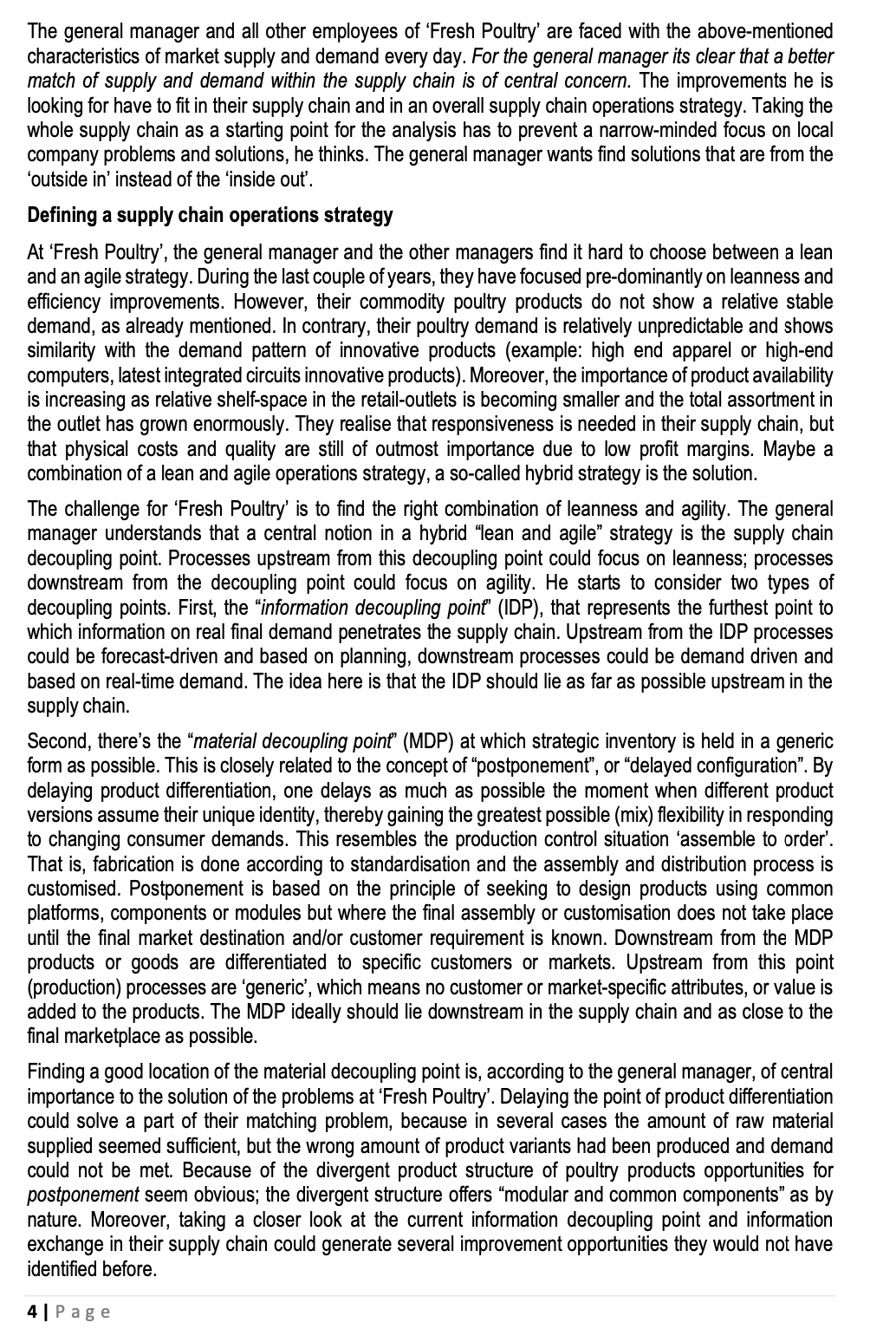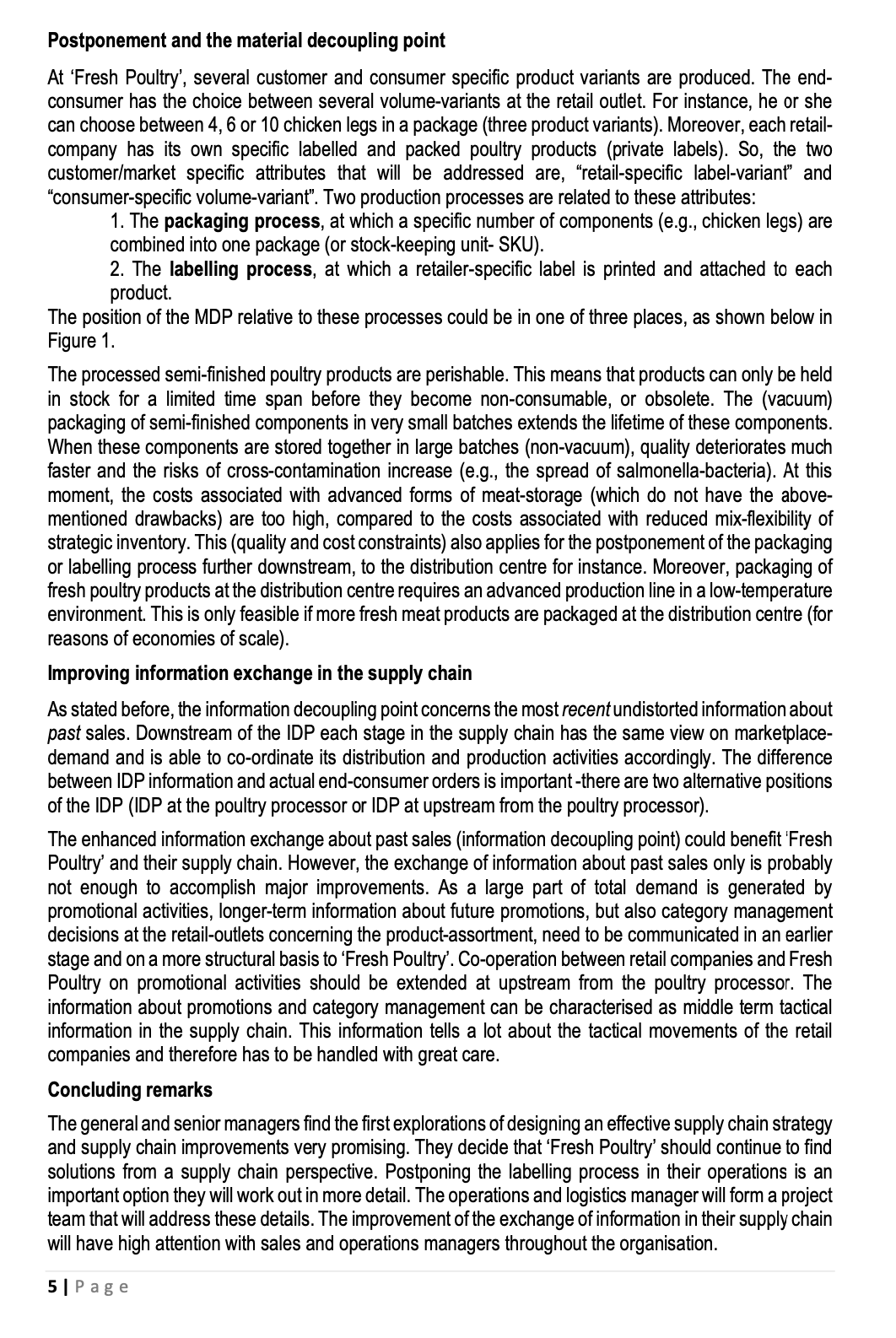Answered step by step
Verified Expert Solution
Question
1 Approved Answer
CASE STUDY QUESTION. - 1. Supply chain and logistics structure : Critically explain how the current supply chain structure of Fresh Poultry constrains the supply
CASE STUDY QUESTION. -
1. Supply chain and logistics structure:
Critically explain how the current supply chain structure of Fresh Poultry constrains the supply chain performance. Discuss how the positions of proposed material decoupling points (MDP) (in Figure 1) affect the supply chain and logistics performance. Identify two mains internal (Fresh Poultry) and two main external (within the supply chain alone) barriers to the implementation of a new MDP (proposed).
CASE STUDY BELOW





The Fresh Poultry Supply Chain At 'Fresh Poultry', a major poultry processor (in the supply chain they can be considered a manufacturer) in Melbourne, Australia, the working day starts very early in the morning. Before a single cock-a-doodle has sounded, live chickens are delivered at the processing plant where they are cleaned, processed, packed and stored. The next day, packages of fresh poultry meat are distributed to several large retail distribution centres and a large number of smaller retail stores. In the evening of that second day, many people will enjoy their chicken Tandoori or fried chicken leg. The product is simple and the whole operation seems efficiently executed. However, at the weekly plenary meeting of senior managers a serious discussion arises. The sales manager complains that the delivery performance has decreased in the last couple of months. Moreover, he complains that retailers are less satisfied with the quality of products they receive. Product freshness and product weight have not been according to specifications several times this month. The operations and purchase managers respond with the remark that the sales department makes sales-agreements with retail that cannot be met in such a short time. They want to know in advance information on promotional activity so they can respond more effectively. They want to have better forecasts of future sales so they can match the supply of chicken with the demand for poultry products. This discussion sounded very familiar to the general manager. He has heard the complaints of the senior managers already many times. Last year they implemented some major improvements to their production process. It now operates more efficiently, with shorter set-up times and less waste. A new planning system has been set up and more frequent meetings between sales and operations have been initiated. The general manager thinks it's time to take a broader perspective on their problem. Flexibility, visibility, and coordination are needed not only in their own operations, but in the whole supply chain as the processes in their supply chain are so strongly coupled. Demand and product characteristics The food and retail market served by 'Fresh Poultry' is very dynamic. In recent years, the range of products offered by most retailers has increased by a factor of 4 to 5 . A single retailer used to stock 4,000 to 5,000 different products (assortment); now they stock 20,000 to 30,000 different products. Obviously, this has had an effect on the assortment of Fresh Poultry' itself. To meet market demand, 'Fresh Poultry' introduced a large number of new fresh poultry products in order to remain competitive. Poultry was packaged in more varieties and combinations and processed in many more ways. They introduced new seasonings and microwaveable ready meals based on poultry products. Their own range grew from 100 to 450 different products. These are typically low margin products. For most food products in Australia, low cost is still an absolute winner in the marketplace. This is true for the end consumer, who buys the products in retail outlets, and for the retailer, who is Fresh Poultry's direct customer. The demand for poultry products by end-consumers shows a very variable pattern and seems unpredictable. This may look strange at first sight but is explained by the heavy use of promotional activities at the retail stage in the supply chain (which are not always communicated in detail to 'Fresh Poultry'). The size of the consumer reaction to a promotion is not easy to predict. If there were no promotional activities, the demand of end-consumers actually shows a more or less seasonal pattern, which is relatively predictable. The promotional activities initiated by the larger retail companies place heavy strains on 'Fresh Poultry' and the upstream supply chain. An opportunity to level demand is to eliminate all promotional activities. However, this encounters much resistance of the retail companies involved; promotions of poultry products are a favourite instrument for competitors to bring in new customers. Meat products are the most expensive components of evening meals, and a reduction of sales price is therefore very interesting for consumers. 2P a g e In addition, the poultry processor like 'Fresh Poultry' itself initiates promotional activities. This is in most times motivated by the need to sell over-production of products. Over-production of specific poultry products will always be the case, because the demand for the different component poultry products is not equal or balanced. Wings, chicken breast and legs are all part of the same chicken but demand for each product is not the same most of the time. An important characteristic of fresh poultry products is "product perishability". Processed poultry stays fresh for a limited number of days, after which the quality deteriorates, and the products are not allowed for human consumption. Product freshness is an important performance indicator in the poultry supply chain. Retail companies demand the highest product freshness possible. One can see that there exists a strong relationship between product freshness, lead-times and inventory turnaround. If turnaround is low and lead-times are long the chance of product obsolescence increases. All products of which the best-before-date has been exceeded are written-off and sold to downstream food-processing industries for a lower price. Furthermore, the end of the supply chain is characterised by very short, required lead times (retail-companies demand a delivery time of between 18 to 48 hours). Retail companies place their orders every day and products are delivered on a high frequency (many times per week). Because of the small lead-times, stock is held at the poultry processor. The required service levels for poultry products are high. The poultry processor has to comply with a minimum delivery reliability of 99 percent, even in the case of promotions. Supply characteristics The supply chain of Fresh Poultry can be characterised as a chain of strongly interconnected processes with minimal possibilities for buffering of products and materials. This is caused by the nature of the "product" exchanges in the supply chain. At the hatchery, eggs are hatched during three weeks and the newborn chickens are immediately transported to the broiler houses. At the broiler houses chickens are fattened over nine weeks and, when reaching the agreed delivery-date or specified weight, delivered to the poultry processor. Because the "goods flow" in this supply chain concerns living chicken, processes cannot be buffered very easily, and short-term co-ordination is of outmost importance. The chickens supplied by the broiler houses have to comply with specific quality characteristics. Chickens have to be from certain races, of a specific weight, fattened with high quality certified feed, and fattened according to several quality systems (e.g., HACCP- Hazard analysis and critical control points and RSPCA). Only broiler houses and hatcheries that comply with these quality specifications are allowed to supply Fresh Poultry. These high-quality specifications are necessary to guarantee food safety of the consumer product. The number of certified broiler houses and hatcheries that are able to supply to 'Fresh Poultry' is therefore limited. Because of the longer lead times at upstream of the poultry supply chain the planned volume of supply is not easily changed. If estimated demand exceeds the planned supply, it is possible to purchase chickens from other broiler houses, but only if they are able to comply with the mentioned quality specification. Another option is that 'Fresh Poultry' purchases finished poultry products from other poultry processors. Most of the times these products have to be repacked and have different quality characteristics with regard to weight and processing procedures. These different quality characteristics sometimes give rise to complaints from the retail companies. However, the purchase of finished poultry product from other processors does not have the disadvantage of over-production of divergent poultry products at 'Fresh Poultry' itself. Matching supply and demand In short, demand uncertainty is relatively high. As a result, the need for production capacity, and thus the need for raw materials (living chickens), fluctuates. The production capacity itself is planned for maximum utilisation (to keep production costs per kg product as low as possible) resulting in low production flexibility. Finally, the supply of (certified) chickens from suppliers has to be planned twelve weeks ahead because of the duration of hatching and fattening stages. The potential for buffering and inventory storage is limited in the supply chain since the quality of the supply (chickens) and of the consumer products will deteriorate. 3P a g e The general manager and all other employees of 'Fresh Poultry' are faced with the above-mentioned characteristics of market supply and demand every day. For the general manager its clear that a better match of supply and demand within the supply chain is of central concern. The improvements he is looking for have to fit in their supply chain and in an overall supply chain operations strategy. Taking the whole supply chain as a starting point for the analysis has to prevent a narrow-minded focus on local company problems and solutions, he thinks. The general manager wants find solutions that are from the 'outside in' instead of the 'inside out'. Defining a supply chain operations strategy At 'Fresh Poultry', the general manager and the other managers find it hard to choose between a lean and an agile strategy. During the last couple of years, they have focused pre-dominantly on leanness and efficiency improvements. However, their commodity poultry products do not show a relative stable demand, as already mentioned. In contrary, their poultry demand is relatively unpredictable and shows similarity with the demand pattern of innovative products (example: high end apparel or high-end computers, latest integrated circuits innovative products). Moreover, the importance of product availability is increasing as relative shelf-space in the retail-outlets is becoming smaller and the total assortment in the outlet has grown enormously. They realise that responsiveness is needed in their supply chain, but that physical costs and quality are still of outmost importance due to low profit margins. Maybe a combination of a lean and agile operations strategy, a so-called hybrid strategy is the solution. The challenge for 'Fresh Poultry' is to find the right combination of leanness and agility. The general manager understands that a central notion in a hybrid "lean and agile" strategy is the supply chain decoupling point. Processes upstream from this decoupling point could focus on leanness; processes downstream from the decoupling point could focus on agility. He starts to consider two types of decoupling points. First, the "information decoupling point" (IDP), that represents the furthest point to which information on real final demand penetrates the supply chain. Upstream from the IDP processes could be forecast-driven and based on planning, downstream processes could be demand driven and based on real-time demand. The idea here is that the IDP should lie as far as possible upstream in the supply chain. Second, there's the "material decoupling point" (MDP) at which strategic inventory is held in a generic form as possible. This is closely related to the concept of "postponement", or "delayed configuration". By delaying product differentiation, one delays as much as possible the moment when different product versions assume their unique identity, thereby gaining the greatest possible (mix) flexibility in responding to changing consumer demands. This resembles the production control situation 'assemble to order'. That is, fabrication is done according to standardisation and the assembly and distribution process is customised. Postponement is based on the principle of seeking to design products using common platforms, components or modules but where the final assembly or customisation does not take place until the final market destination and/or customer requirement is known. Downstream from the MDP products or goods are differentiated to specific customers or markets. Upstream from this point (production) processes are 'generic', which means no customer or market-specific attributes, or value is added to the products. The MDP ideally should lie downstream in the supply chain and as close to the final marketplace as possible. Finding a good location of the material decoupling point is, according to the general manager, of central importance to the solution of the problems at 'Fresh Poultry'. Delaying the point of product differentiation could solve a part of their matching problem, because in several cases the amount of raw material supplied seemed sufficient, but the wrong amount of product variants had been produced and demand could not be met. Because of the divergent product structure of poultry products opportunities for postponement seem obvious; the divergent structure offers "modular and common components" as by nature. Moreover, taking a closer look at the current information decoupling point and information exchange in their supply chain could generate several improvement opportunities they would not have identified before. 4P a g e Postponement and the material decoupling point At 'Fresh Poultry', several customer and consumer specific product variants are produced. The endconsumer has the choice between several volume-variants at the retail outlet. For instance, he or she can choose between 4,6 or 10 chicken legs in a package (three product variants). Moreover, each retailcompany has its own specific labelled and packed poultry products (private labels). So, the two customer/market specific attributes that will be addressed are, "retail-specific label-variant" and "consumer-specific volume-variant". Two production processes are related to these attributes: 1. The packaging process, at which a specific number of components (e.g., chicken legs) are combined into one package (or stock-keeping unit- SKU). 2. The labelling process, at which a retailer-specific label is printed and attached to each product. The position of the MDP relative to these processes could be in one of three places, as shown below in Figure 1. The processed semi-finished poultry products are perishable. This means that products can only be held in stock for a limited time span before they become non-consumable, or obsolete. The (vacuum) packaging of semi-finished components in very small batches extends the lifetime of these components. When these components are stored together in large batches (non-vacuum), quality deteriorates much faster and the risks of cross-contamination increase (e.g., the spread of salmonella-bacteria). At this moment, the costs associated with advanced forms of meat-storage (which do not have the abovementioned drawbacks) are too high, compared to the costs associated with reduced mix-flexibility of strategic inventory. This (quality and cost constraints) also applies for the postponement of the packaging or labelling process further downstream, to the distribution centre for instance. Moreover, packaging of fresh poultry products at the distribution centre requires an advanced production line in a low-temperature environment. This is only feasible if more fresh meat products are packaged at the distribution centre (for reasons of economies of scale). Improving information exchange in the supply chain As stated before, the information decoupling point concerns the most recent undistorted information about past sales. Downstream of the IDP each stage in the supply chain has the same view on marketplacedemand and is able to co-ordinate its distribution and production activities accordingly. The difference between IDP information and actual end-consumer orders is important -there are two alternative positions of the IDP (IDP at the poultry processor or IDP at upstream from the poultry processor). The enhanced information exchange about past sales (information decoupling point) could benefit 'Fresh Poultry' and their supply chain. However, the exchange of information about past sales only is probably not enough to accomplish major improvements. As a large part of total demand is generated by promotional activities, longer-term information about future promotions, but also category management decisions at the retail-outlets concerning the product-assortment, need to be communicated in an earlier stage and on a more structural basis to 'Fresh Poultry'. Co-operation between retail companies and Fresh Poultry on promotional activities should be extended at upstream from the poultry processor. The information about promotions and category management can be characterised as middle term tactical information in the supply chain. This information tells a lot about the tactical movements of the retail companies and therefore has to be handled with great care. Concluding remarks The general and senior managers find the first explorations of designing an effective supply chain strategy and supply chain improvements very promising. They decide that 'Fresh Poultry' should continue to find solutions from a supply chain perspective. Postponing the labelling process in their operations is an important option they will work out in more detail. The operations and logistics manager will form a project team that will address these details. The improvement of the exchange of information in their supply chain will have high attention with sales and operations managers throughout the organisation. 5 | P a g e Figure 1. Material decoupling point options at 'Fresh Poultry' At the plenary meeting, the above-mentioned findings are presented. At the end of the meeting everybody has his and her own thoughts and doubts about the proposed improvements. Everybody agrees that a supply chain operations strategy that combines the lean and agile paradigms is most feasible, but how to implement this is still not very clear to some managers. Especially the improvement of the exchange of tactical information about promotions seems not very easy to accomplish. The general manager acknowledges this and wants to set up a project team with one of their main customers to explore in more detail how to improve the planning of promotional activities
Step by Step Solution
There are 3 Steps involved in it
Step: 1

Get Instant Access to Expert-Tailored Solutions
See step-by-step solutions with expert insights and AI powered tools for academic success
Step: 2

Step: 3

Ace Your Homework with AI
Get the answers you need in no time with our AI-driven, step-by-step assistance
Get Started


